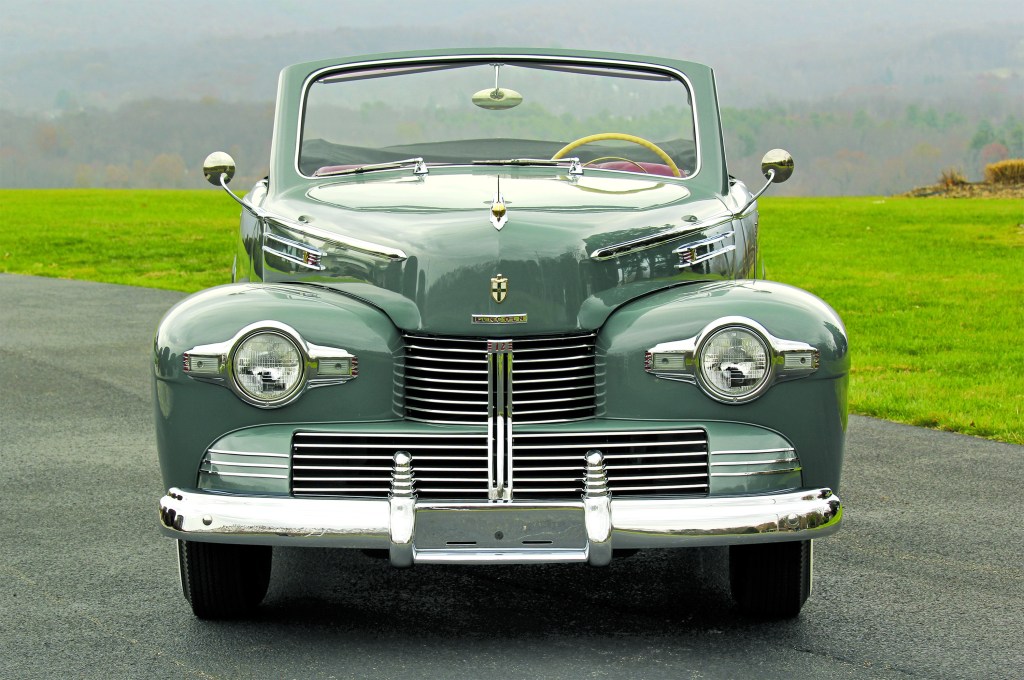
THE 1942 LINCOLN-ZEPHYR USHERED OUT AN ERA WITH V-12 POWER
A new Lincoln for a new era, the Lincoln-Zephyr was a success from its introduction for the 1936 model year. Unlike the stately Model K Lincolns that had established the company’s enviable reputation in the luxury field, the handsome and innovative Zephyr was aimed at the upper medium-priced market, where it would square off against the Packard One-Twenty and Cadillac’s new Series 60.
Later hailed by the Museum of Modern Art in New York as “the first successfully designed streamlined car in America,” the Zephyr was based on a design developed by John Tjaarda at Briggs, with the support of Lincoln’s president, Edsel Ford. The new car was meant to have a mid-mounted Ford V-8, but when public viewings of prototypes showed buyer reluctance, the design was abandoned in favor of a conventional front-engine, rear-drive configuration. E.T. “Bob” Gregorie, who had been tabbed by Edsel Ford to lead Ford Motor Company’s new design department in 1935, was brought in at that point to create a new front end, coming up with the distinctive V-shaped prow with headlamps faired into the fenders.
More than sleek styling would distinguish the new Zephyr. Believing that V-8 power was not good enough for a car bearing the Lincoln name, Edsel Ford gave his chief engineer, Frank Johnson, the job of designing a small V-12 that would be affordable to produce. The 267-cu.in. flathead he created featured aluminum alloy heads and cast steel pistons, and churned out 110 hp, enough to give a top speed of more than 90 mph.
The V-12 was not just an expanded version of the flathead Ford V-8, though the two did share some components. Rather than the 90-degree vee angle of the Ford engine, Johnson selected a 75-degree vee, giving enough space in the valley for central induction manifolding while keeping the overall package compact. Though it had uneven firing intervals with its conventional crankshaft, the V-12 was remarkable for its smoothness—and it was a plus that no one else in the market segment had. “Have you ever driven a twelve-cylinder car? Now you can drive and own one!” the ads proclaimed.
Buyers snapped up 14,994 Lincoln-Zephyrs in the model’s first year, against 1,515 of the big Model Ks. The first major design change came in 1938, when Gregorie decided to switch to a horizontal radiator for better engine cooling. The low, horizontal grilles, one on either side of the pointed prow, were immensely influential, prompting General Motors and Chrysler to follow suit. “That was the beginning of the horizontal grille thing, but they never knew why we had to do this,” Gregoire is quoted as saying in Nick Georgano’s Art of the American Automobile; “What it did, it created a whole styling change in the American car.” With further refinements, the 1940 Zephyr served as the basis for Gregoire’s landmark Continental, designed for Edsel Ford.
Zephyr production peaked at 29,997 for 1937 but was still going strong when America’s impending involvement in World War II led Detroit’s factories to shift to military production in the midst of the 1942 model year. The Zephyr convertible coupe shown here was built on January 9, 1942, making it one of the last Lincolns to roll off the line until the end of the war. Lincoln promoted its Zephyr as “massively streamlined” for ’42, with a “lower, longer, and wider appearance.” A bright, two-tier grille connected the broad-shouldered front fenders, while the bezels for the headlamps were widened to accommodate the parking lamps and directional signals. Front tread grew by 2.5 inches, and the car was 7 inches longer than its predecessor. The V-12 was bored out to 306-cu.in., gaining another 20 hp despite a drop in the compression ratio. 1942 was also marked by the introduction of the Liquamatic Drive semi-automatic transmission, a failure that was quickly and quietly abandoned.
The 1942 models were the last to wear the Zephyr name, but the basic design remained when production resumed in 1946 and lasted until 1948. Zephyr production for 1942 amounted to just 4,418, with convertible coupes accounting for a mere 191 of those. We couldn’t find a 1942 Lincoln-Zephyr of any body style on Hemmings Marketplace, though we did find two beautifully restored 1940 convertibles with asking prices of $79,500 and $59,500. Classic.com reported no sales at auction of any ’42 convertibles over the past five years but did record the sale of a sedan that had been on long-term display at a museum for $10,000 in May.
Specifications – 1942 Lincoln-Zephyr
- Engine 306-cu.in. L-head V-12, 7.0:1 compression ratio, 130 hp at 3,600 rpm
- Transmission Three-speed manual
- Suspension Transverse leaf spring, solid axle
- Brakes Hydraulic, four-wheel drum
- Wheelbase 125 inches
- Curb weight 3,980 pounds
- Price new $2,150
- Value today N/A
The post The 1942 Lincoln-Zephyr Ushered Out An Era With V-12 Power appeared first on The Online Automotive Marketplace.
2024-09-13T15:37:05Z dg43tfdfdgfd